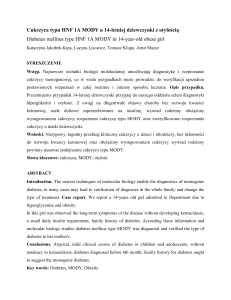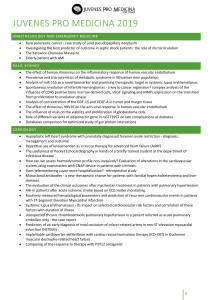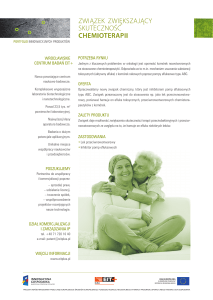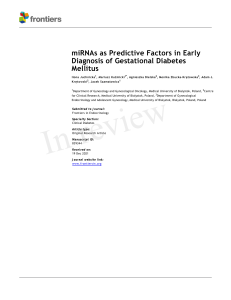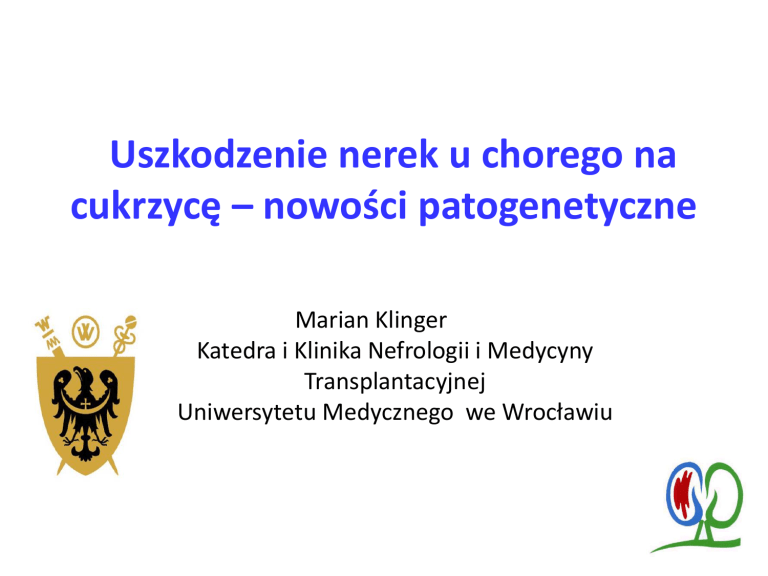
Uszkodzenie nerek u chorego na
cukrzycę – nowości patogenetyczne
Marian Klinger
Katedra i Klinika Nefrologii i Medycyny
Transplantacyjnej
Uniwersytetu Medycznego we Wrocławiu
Patogeneza cukrzycowego uszkodzenia
nerek
hiperglikemia
czynniki hemodynamiczne
reakcja zapalna
zróżnicowane, wielogenowe podłoże
Rozwój uszkodzenia nerek w cukrzycy
Kimberly Reidy et al., Molecular mechanisms of diabetic kidney disease. J Clin Invest. 2014;124(6):2333–2340
Pathogenesis of kidney disease in patients with diabetes. Hemodynamic and metabolic factors, with a central role for
chronic hyperglycaemia, have pivotal roles in the pathophysiology of diabetic nephropathy.
Muskiet, M. H. A. et al. Nat. Rev. Nephrol. 10, 88–103 (2014);
Aowen Zhuang & Josephine M Forbes: Stress in the kidney is the road to pERdition: is endoplasmic reticulum stress a pathogenic
mediator of diabetic nephropathy? Journal of Endocrinology (2014) 222, R97–R111
Aowen Zhuang & Josephine M Forbes: Stress in the kidney is the road to pERdition: is endoplasmic reticulum stress a
pathogenic mediator of diabetic nephropathy? Journal of Endocrinology (2014) 222, R97–R111
García-García PM, Getino-Melián MA, Domínguez-Pimentel V,Navarro-González JF. Inflammation in
diabetic kidney disease. World J Diabetes 2014; 5(4): 431-443
Kimberly Reidy et al.
J Clin Invest. 2014;
124(6):2333–2340
Molecular mechanisms of
diabetic kidney disease
Zaburzenia ekspresji genów
[Tang Z.-H., Fang Z. and Zhou L. 2013 Human genetics of diabetic vascular complications. J. Genet. 92, 677–694]
Cukrzycowe uszkodzenie nerek bez białkomoczu;
Nie wszystko zależy od podocyta
Diabetic kidney disease with and without albuminuria
Richard J. Mac Isaac and George Jerums
Current Opinion in Nephrology and Hypertension 2011, 20:246–
257
Summary
The conventional paradigm of kidney disease in people with
diabetes has been challenged. Changes in AER and GFR are being
increasingly recognized as complementary rather than obligatory
manifestations of diabetic CKD
Klasyczny przebieg uszkodzenia nerek w cukrzycy typu 1
MacIsaac and Jerums, Curr Opin Nephrol Hypertens 20:246–257, 2011
Klasyczny przebieg uszkodzenia nerek w cukrzycy typu 2
MacIsaac and Jerums, Curr Opin Nephrol Hypertens 20:246–257, 2011
MacIsaac and Jerums, Curr Opin Nephrol Hypertens 20:246–257, 2011
MacIsaac and Jerums, Curr Opin Nephrol Hypertens 20:246–257, 2011
MacIsaac and Jerums, Curr Opin Nephrol Hypertens 20:246–257, 2011
A.K. Mottl et al. / Journal of Diabetes and Its Complications 27 (2013) 123–127
A.K. Mottl et al. / Journal of Diabetes and Its Complications 27 (2013) 123–127
A.K. Mottl et al. / Journal of Diabetes and Its Complications 27 (2013) 123–127
Odrębności obrazu patofizjologicznego i
klinicznego uszkodzenia nerek w cukrzycy
typu 1 i 2
Diabetic Kidney Disease in Elderly Individuals
CKD in the elderly diabetic population may
frequently lack proteinuria and therefore be less
responsive to RAS blockade. In NHANES III, a
third of those surveyed with type 2 diabetes
aged 60 to 70 years and with normal urinary
albumin excretion nonetheless had a GFR of less
than 30 mL/min, and almost half were between
30 and 60 mL/min.
Williams, Med Clin N Am 97 (2013) 75–89
Median Glycated Hemoglobin Levels at Each Study Visit
The Action to Control Cardiovascular Risk in Diabetes
Study Group. N Engl J Med 2008;358:2545-2559
10,251 patients (mean age, 62.2 years)
The primary outcome was a composite
of nonfatal myocardial infarction,
nonfatal stroke, or death from
cardiovascular causes. The finding of
higher mortality in the intensive-therapy
group led to a discontinuation of
intensive therapy after a mean of 3.5
years of follow-up.
During follow-up, the primary outcome occurred in
352 patients in the intensive-therapy group, as
compared with 371 in the standard-therapy group
(hazard ratio, 0.90; 95% confidence interval [CI], 0.78
to 1.04; P=0.16). At the same time, 257 patients in the
intensive-therapy group died, as compared with 203
patients in the standard-therapy group (hazard ratio,
1.22; 95% CI, 1.01 to 1.46; P=0.04). Hypoglycemia
requiring assistance and weight gain of more than 10
kg were more frequent in the intensive-therapy group
(P<0.001).
General atherosclerosis
Harm of hypoperfusion
The effect of RAAS blockade on the
progression of diabetic nephropathy
Sara S. Roscioni, Hiddo J. Lambers Heerspink
and Dick de Zeeuw
Nat. Rev. Nephrol. 10, 77–87 (2014)
Roscioni, S. S. et al. Nat. Rev. Nephrol. 10, 77–87 (2014))
Roscioni, S. S. et al. Nat. Rev. Nephrol. 10, 77–87 (2014) .
Roscioni, S. S. et al. Nat. Rev. Nephrol. 10, 77–87 (2014)
The gut–renal axis: do incretin-based agents
confer renoprotection in diabetes?
Marcel H. A. Muskiet, Mark M. Smits, Linde
M. Morsink and Michaela Diamant
Nat. Rev. Nephrol. 10, 88–103 (2014)
The gut–renal axis
Muskiet, M. H. A. et al. Nat. Rev. Nephrol. 10, 88–103 (2014);
Muskiet, M. H. A. et al. Nat. Rev. Nephrol. 10, 88–103 (2014);
Podsumowanie
Nie ma jednolitego patomechanizmu
cukrzycowego uszkodzenia nerek,
obejmującego wszystkich chorych
Są różnice między cukrzycą typu 1 i 2
Przyspieszony proces miażdżycowy
bywa głównym wyznacznikiem ubytku
filtracji, zwłaszcza u starszych osób

